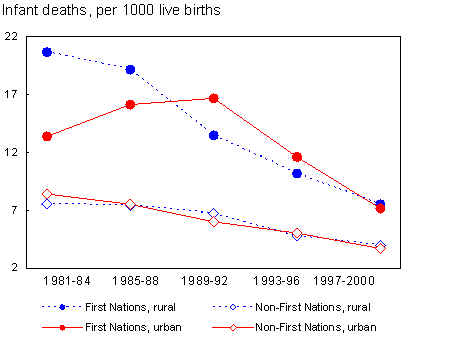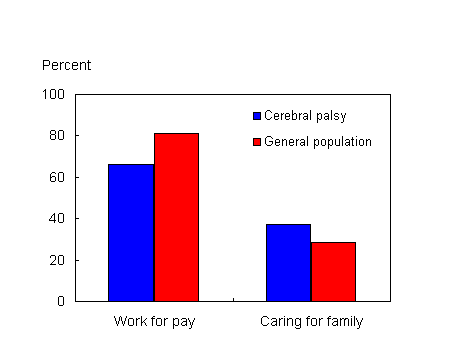Collaboration with external researchers
Most HAMG projects involve collaboration with researchers at universities
or other government agencies. This work often explores new methods
for examining the health of Canadian subpopulations using Statistics
Canada and other databases.
The summaries below highlight several papers by HAMG and external
collaborators that have appeared in peer-reviewed journals over
the past few months. One of these analyses used national health
survey data; two used linked birth and infant death files; and one
used two national health surveys and a survey by university researchers.
Abstracts of these papers are available through PubMed at http://www.ncbi.nlm.nih.gov/entrez
Neighbourhood influences on
health in Montréal
Infant mortality among First Nations
and non-First Nations people in British Columbia
Health of primary caregivers of
children with cerebral palsy
Pregnancy outcomes based on marital
and cohabitation status in Quebec
Other recent releases
Neighbourhood influences on health in Montréal
a collaboration of Statistics Canada and researchers at the Department
of Geography at McGill University
This study of the Montréal health region showed that neighbourhood
had an impact on health over and above the impact of individual
risk factors. These risk factors include smoking, obesity, high
stress, and low sense of belonging to the community, all of which
have significant negative effects on health. Household income is
also associated with health—the lower the income group, the
worse their health.
Such studies are important because of increasing evidence that
social structures within neighbourhoods can affect educational attainment,
employment success, or social connectedness, which in turn can influence
individual health.
These results are consistent with other Canadian work showing that
the effect of neighbourhood is relatively small.
This study is one of the few to examine the effects of neighbourhoods
on health in Canada. Other studies have shown that neighbourhoods
affect health in the United States and the United Kingdom. But the
few Canadian studies conducted to date suggest that neighbourhood
effects in Canada are much smaller, possibly as a result of policies
and programs that aim to reduce economic and health disparities.
This study used 2000/01 Canadian Community Health Survey data for
the Montréal health region.
This study is unique in using "natural" neighbourhoods
defined by local government and real estate boards as the unit of
analysis.
Ross NA, Tremblay S, Graham K. Neighbourhood influences on health
in Montréal, Canada. Soc Sci Med 2004; 59(7): 1485-94.
Infant mortality among First Nations and non-First
Nations people in British Columbia
a collaboration of Statistics Canada, McGill University, the University
of British Columbia, and the British Columbia Vital Statistics Agency
First Nations infants were more likely to be born pre-term, but
have heavier birth weights, than non-First Nations infants.This
was the case in both rural and urban areas of the province.
In addition, infant mortality rates were more than twice as high
among First Nations as non-First Nations people. Post-neonatal mortality
rates were 3.6 times as high (Figure 1).
Figure 1
Infant mortality rates higher among First Nations

However, from 1981 to 2000, infant mortality rates declined 64%
for First Nations people living in rural areas, and declined 47%
for those in urban areas.
Relative risks of infant mortality for First Nations compared with
non-First Nations people were similar for both poor and rich neighbourhoods.
This suggests that these disadvantages may be independent of neighbourhood
socio-economic status.
Most of the excess infant mortality among First Nations people
was due to higher post-neonatal mortality, in particular, deaths
due to preventable causes, such as sudden infant death syndrome,
infection and external causes. This suggests the need for improved
socio-economic and living conditions.
The differences in neonatal mortality were largely attributable
to higher rates of pre-term birth among First Nations people, rather
than to differences in gestational age-specific neonatal mortality,
which were not observed.
Luo ZC, Kierans WJ, Wilkins R, Liston RM, Uh SH, and Kramer MS.
Infant mortality among First Nations versus non-First Nations in
British Columbia: temporal trends in rural versus urban areas, 1981-2000.
Int J Epidemiol 2004; 33(6): 1252-9.
Health of primary caregivers of children with
cerebral palsy
a collaboration of Statistics Canada, the Ottawa Health Research
Institute, the University of Ottawa, and the CanChild Centre for
Childhood Disability Research at McMaster University
Caregivers of children with cerebral palsy reported more psychological
and physical health problems than caregivers of children in general,
despite few differences in social support.
For example, they were more likely to report emotional problems
and multiple chronic health conditions such as back problems, migraines,
asthma, ulcers and heart disease.
The study was based on data from two Statistics Canada surveys
(the National Population Health Survey and the National Longitudinal
Survey of Children and Youth), and CanChild's study "Caring
about caregivers", which covered caregivers of children with
cerebral palsy in Ontario.
Caregivers of children with cerebral palsy were also more likely
to have lower incomes than other caregivers in general, even though
levels of education were similar in the two groups of caregivers.
Only 66% of caregivers of children with cerebral palsy worked for
pay, compared with 81% of those in the general population. They
were also less likely to engage in full-time work, and more likely
to report caring for family as their main activity (Figure 2).
Figure 2
Caregivers of children with cerebral palsy less likely to
work for pay, more likely to care for family as main activity

This study of caregivers of children with disabilities is unique
because it examined both the physical and psychological health of
caregivers. It is also the first to use a large nationally representative
sample of caregivers for comparison.
Brehaut JC, Kohen DE, Raina P, et al. The health of primary caregivers
of children with cerebral palsy: how does it compare to other Canadian
caregivers? Pediatrics 2004; 114(2): e182- e191.
http://pediatrics.aapublications.org/cgi/content/full/114/2/e182
Pregnancy outcomes based on marital and cohabitation
status in Quebec
a collaboration of Statistics Canada, McGill University, and the
Fetal and Infant Health Study Group of the Canadian Perinatal Surveillance
System
Mothers living in common-law unions were more likely to have had
adverse pregnancy outcomes than those in traditional marriage relationships,
according to this study of pregnancy outcomes in Quebec.
Modest disparities in adverse pregnancy outcomes between common-law
and traditional marriage relationships persisted during the 1990s,
despite a striking increase in common-law unions.
The adverse risks associated with common-law unions were diminished
for mothers with higher educational attainment compared with those
with less education. But the risks were intensified for Aboriginal
mothers compared with other ethnic groups.
Some of the differences in adverse pregnancy outcomes may be related
to maternal smoking, which is more common among women in common-law
unions compared with those who are legally married. Mothers in common-law
unions may also experience greater stress during pregnancy owing
to less stable relationships than those in traditional marriage.
Unmarried women are known to have greater risks of adverse pregnancy
outcomes than married women. However, most previous studies have
not made a distinction between mothers living in common-law unions,
legally married mothers and mothers living alone.
Lone mothers had even worse pregnancy outcomes than mothers living
in common-law unions. However, the risks among common-law mothers
are of greater public health concern because of the high and increasing
proportion of births to mothers in common-law unions.
In 1997, 44% of births in Quebec were to common-law mothers, more
than double the proportion in 1990.
Adverse pregnancy outcomes include pre-term birth, low birth weight,
small-for-gestational-age, stillbirth, and neonatal and post-neonatal
mortality.
Luo ZC, Wilkins R, Kramer MS; Fetal and Infant Health Study Group
of the Canadian Perinatal Surveillance System. Disparities in pregnancy
outcomes according to marital and cohabitation status. Obstetrics
and Gynecology 2004; 103(6): 1300-7.
Other recent releases
Luo ZC, Kierans WB, Wilkins R, Liston RM, Mohamed J, Kramer MS; the
British Columbia Vital Statistics Agency. Disparities in birth outcomes
by neighborhood income: temporal trends in rural and urban areas,
British Columbia. Epidemiology 2004; 15(6): 679-86.
Summary at /daily-quotidien/041116/dq041116a-eng.htm
Ross NA, Houle C, Dunn JR, Aye M. Dimensions and dynamics of residential
segregation by income in urban Canada, 1991 to 1996. Canadian Geographer
2004; 48(4): 433-45. Full text at http://www.blackwell-synergy.com
Ng E, Wilkins R, Gendron F, Berthelot J-M. Dynamics of immigrants'
health in Canada: evidence from the National Population Health Survey.
Catalogue no. 82-618-MWE2005002. Healthy today, healthy tomorrow?
Findings from the National Population Health Survey. Ottawa: Statistics
Canada; 2005. :8096/bsolc/english/bsolc?catno=82-618-MWE2005002
Joseph KS, Wilkins R, Dodds L, Allen VM, Ohlsson A, Marcoux S et
al. Customized birth weight for gestational age standards: Perinatal
mortality patterns are consistent with separate standards for males
and females but not for blacks and whites. BMC Pregnancy and Childbirth
2005; 5(3). http://www.biomedcentral.com/1471-2393/5/3
|

































